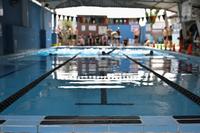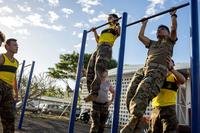How can you improve your swimming skill in the most efficient manner? Many beginner swimmers tend to jump right into the pool and start swimming once they can get good enough to swim across it for the first time.
Getting across the pool on pure guts alone, though, is no way to improve your swimming ability. In fact, learning proper technique will make swimming so much easier, and it is worth the time and money to master basic stroke techniques.
Here is an email asking for help with the swimming portion of the Navy physical screening test (PST):
I am preparing for the Navy PST. How hard should I be pushing myself when swimming as an inexperienced swimmer? I swim 5 days a week and want to push myself, but also be smart about how much I exert myself. Thanks, Eric
The military is not going to require you to be at the level of a competitive swimmer, even if you are seeking some of the more challenging special ops swimming tests. While you need to be efficient, conditioned and competent, a history of swim-team experience is not required to join these groups.
Actually, most people who attend these programs do not have to spend time learning how to swim effectively. But they learn how to swim efficiently enough, and that requires technique training.
Streamlined Power Is Key
The most essential piece of swimming technique advice is to think of a streamlined body position like a torpedo. Then use your arms like oars, and feet and legs like outboard motors. Creating power in your strokes and kicks and gliding nicely through the water is what you will learn from a swimming coach.
You may find some common exercises you can do on land to help with developing a powerful kick like jumping lunges and jumping squats. There is no need to add weight, but you can do more of an explosive upward movement of the lift to create power. Swimming with fins will help you develop a scissor kick and more powerful flutter kicks, too.
Time in the Water
Good job getting into the pool five days a week. My advice is to swim 1,000-1,500 meters each time you do a swim workout. These distances will get you the time you need in the water and the conditioning you need for the 500-yard swim test. But you also should receive constructive feedback on your technique, practice proper technique and then get in shape to swim your goal distance and time.
Use your phone and have someone walk alongside the pool while you swim 50 yards so that you can see what you are doing. Then compare yourself to other videos, using that stroke as your homework. That is a lot to unpack, but you cannot just go to a pool and swim five times per week with no real plan or technique training.
A Classic Workout
If you need a workout to help you master the basics of technique and build the level of conditioning you need, look no further than the 50-50 Swim Workout. In this workout, you should practice two strokes: freestyle for conditioning and the combat swimmer stroke (CSS) or breaststroke for technique.
For most of us non-swimming athletes, you may need to budget significant time to get you to the level of swimming proficiency you need in these military swimming and diving professions. You may need the help of a friend who swims, watch people who can swim or hire a coach. But the technique is the first key to success. Otherwise, you are wasting time and energy.
Stew Smith is a former Navy SEAL and fitness author certified as a Strength and Conditioning Specialist (CSCS) with the National Strength and Conditioning Association. Visit his Fitness eBook store if you're looking to start a workout program to create a healthy lifestyle. Send your fitness questions to stew@stewsmith.com.
Want to Learn More About Military Life?
Whether you're thinking of joining the military, looking for fitness and basic training tips, or keeping up with military life and benefits, Military.com has you covered. Subscribe to Military.com to have military news, updates and resources delivered directly to your inbox.


















